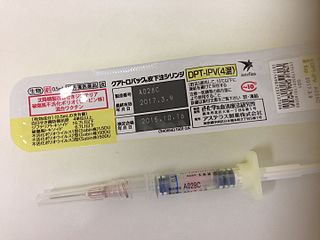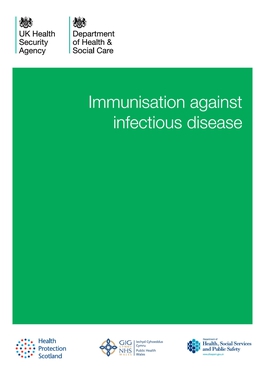
The DPT vaccine or DTP vaccine is a class of combination vaccines against three infectious diseases in humans: diphtheria, pertussis, and tetanus. The vaccine components include diphtheria and tetanus toxoids and either killed whole cells of the bacterium that causes pertussis or pertussis antigens. The term toxoid refers to vaccines which use an inactivated toxin produced by the pathogen which they are targeted against in order to generate an immune response. In this way, the toxoid vaccine generates an immune response which is targeted against the toxin which is produced by the pathogen and causes disease, rather than a vaccine which is targeted against the pathogen itself. The whole cells or antigens will be depicted as either "DTwP" or "DTaP", where the lower-case "w" indicates whole-cell inactivated pertussis and the lower-case "a" stands for "acellular". In comparison to alternative vaccine types, such as live attenuated vaccines, the DTP vaccine does not contain the pathogen itself, but rather uses inactivated toxoid to generate an immune response; therefore, there is not a risk of use in populations that are immune compromised since there is not any known risk of causing the disease itself. As a result, the DTP vaccine is considered a safe vaccine to use in anyone and it generates a much more targeted immune response specific for the pathogen of interest. However, booster doses are recommended every ten years to maintain immune protection against these pathogens.

Pulse Polio is an immunisation campaign established by the government of India to eliminate poliomyelitis (polio) in India by vaccinating all children under the age of five years against the polio virus. The project fights polio through a large-scale, pulse vaccination programme and monitoring for poliomyelitis cases.

A vaccination schedule is a series of vaccinations, including the timing of all doses, which may be either recommended or compulsory, depending on the country of residence. A vaccine is an antigenic preparation used to produce active immunity to a disease, in order to prevent or reduce the effects of infection by any natural or "wild" pathogen. Vaccines go through multiple phases of trials to ensure safety and effectiveness.

PATH is an international, nonprofit global health organization. PATH is based in Seattle with 1,600 employees in more than 70 countries around the world. Its president and CEO is Nikolaj Gilbert, who is also the Managing Director and CEO of Foundations for Appropriate Technologies in Health (FATH), PATH's Swiss subsidiary. PATH focuses on six platforms: vaccines, drugs, diagnostics, devices, system, and service innovations.
A vaccination policy is a health policy adopted in order to prevent the spread of infectious disease. These policies are generally put into place by State or local governments, but may also be set by private facilities, such as workplaces or schools. Many policies have been developed and implemented since vaccines were first made widely available.

Neonatal tetanus is a form of generalised tetanus that occurs in newborns. Infants who have not acquired passive immunity from an immunized mother are at risk. It usually occurs through infection of the unhealed umbilical stump, particularly when the stump is cut with a non-sterile instrument. Neonatal tetanus mostly occurs in developing countries, particularly those with the least developed health infrastructure. It is rare in developed countries.

Pertussis vaccine is a vaccine that protects against whooping cough (pertussis). There are two main types: whole-cell vaccines and acellular vaccines. The whole-cell vaccine is about 78% effective while the acellular vaccine is 71–85% effective. The effectiveness of the vaccines appears to decrease by between 2 and 10% per year after vaccination with a more rapid decrease with the acellular vaccines. The vaccine is only available in combination with tetanus and diphtheria vaccines. Pertussis vaccine is estimated to have saved over 500,000 lives in 2002.
Universal Immunisation Programme (UIP) is a vaccination programme launched by the Government of India in 1985. It became a part of Child Survival and Safe Motherhood Programme in 1992 and is currently one of the key areas under National Rural Health Mission since 2005. The programme now consists of vaccination for 12 diseases- tuberculosis, diphtheria, pertussis, tetanus, poliomyelitis, measles, hepatitis B, diarrhoea, Japanese encephalitis, rubella, pneumonia and Pneumococcal diseases. Hepatitis B and Pneumococcal diseases were added to the UIP in 2007 and 2017 respectively. The cost of all the vaccines are borne by the state and the government spent ₹3,587 crore (US$450 million) in 2017 to purchase the vaccines to provide them for free.

GAVI, officially Gavi, the Vaccine Alliance is a public–private global health partnership with the goal of increasing access to immunization in poor countries. In 2016, Gavi channeled more than half of total donor assistance for health, and most donor assistance for immunization, by monetary measure.
Both maternal and child health are interdependent and substantially contributing to high burden of mortality worldwide. Every year, 289 000 women die due to complications in pregnancy and childbirth, and 6.6 million children below 5 years of age die of complications in the newborn period and of common childhood diseases. Sub-Saharan Africa (SSA), which includes Tanzania, contribute higher proportion of maternal and child mortality. Due to considerable proportion of mortality being attributed by maternal and child health, the United Nations together with other international agencies incorporated the two into Millennium Development Goals (MDGs) 4 and 5. In this regard, Tanzania through the Ministry of Health and Social Welfare (MoHSW) adopted different strategies and efforts to promote safe motherhood and improve child survival. Similarly, in an effort to improve maternal and child health, Tanzania's government has declared maternal and child health services to be exempt from user fees in government facilities.

Targeted immunization strategies are approaches designed to increase the immunization level of populations and decrease the chances of epidemic outbreaks. Though often in regards to use in healthcare practices and the administration of vaccines to prevent biological epidemic outbreaks, these strategies refer in general to immunization schemes in complex networks, biological, social or artificial in nature. Identification of at-risk groups and individuals with higher odds of spreading the disease often plays an important role in these strategies, since targeted immunization in high-risk groups is necessary for effective eradication efforts and has a higher return on investment than immunizing larger but lower-risk groups.
India National PolioPlus Society is a non-profit organization. The Initiative has achieved significant progress toward its goals. There has been a dramatic decline in cases everywhere in the seventeen years since the target was set in 1988.

The Australian National Immunisation Program Schedule sets out the immunisations Australians are given at different stages in their life. The program aims to reduce the number of preventable disease cases in Australia by increasing national immunisation coverage. The program starts for an Australian when they are born. Vaccinations are given at birth, then again when the baby is 2 months, 4 months, 6 months, 12 months and 18 months. The immunisation schedule continues when the child is 4 years old, and then into adolescent years. The program is not compulsory and parents have the choice if they want their child vaccinated.

Vaccination in India includes the use of vaccines in Indian public health and the place of vaccines in Indian society, policy, and research.
Helen Aspasia Petousis-Harris is a New Zealand vaccinologist and associate professor in the Department of General Practice and Primary Health Care at the University of Auckland. She has been involved in research related to vaccination in New Zealand since 1998, with her main areas of focus being vaccine safety and effectiveness. Petousis-Harris has had a variety of lead roles in New Zealand and international organisations that focus on vaccination and is a regular media spokesperson in this field, especially during the COVID-19 pandemic.

Shabir Ahmed Madhi is a South African physician who is professor of vaccinology and director of the South African Medical Research Council Respiratory and Meningeal Pathogens Research Unit at the University of the Witwatersrand, and National Research Foundation/Department of Science and Technology Research Chair in Vaccine Preventable Diseases. In January 2021, he was appointed Dean of the Faculty of Health Sciences at the University of the Witwateratand.

Vaccine wastage is the number of vaccines that have not been administered during vaccine deployment in an immunization program. The wastage can occur at multiple stages of the deployment process, and can take place in both unopened and opened vials, or in oral admission. It is an expected part of vaccination deployment and is factored into the manufacturing process.

CoWIN is an Indian government web portal for COVID-19 vaccination registration, owned and operated by India's Ministry of Health and Family Welfare. It displays booking slots of COVID-19 vaccine available in the nearby areas and can be booked on the website. The site also provides vaccination certificates to the beneficiaries, which act as Vaccine Passports during the COVID-19 pandemic for the beneficiaries and can be stored in Digilocker. Users can access the platform via desktop, tablet, and mobile phones.

Immunisation against infectious disease, popularly known as The Green Book, provides information on vaccines for vaccine-preventable diseases. It acts as a guide to the UK's vaccination schedule for health professionals and health departments that give vaccines in the United Kingdom.
Live recombinant vaccines are biological preparations that improve immunity through the utilisation of live bacteria or viruses that are genetically modified. These live pathogens are biologically engineered to express exogenous antigens in the cytoplasm of target cells, triggering immune responses as a result. This form of vaccine combines the beneficial features of attenuated and recombinant vaccines, providing the preparation with attenuated vaccines’ long-lasting immunity and recombinant vaccines’ genetically engineered precision and safety.
















